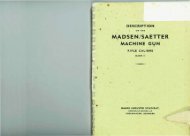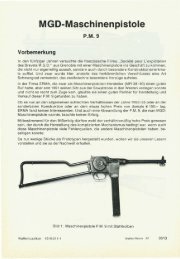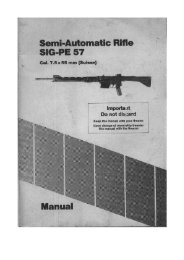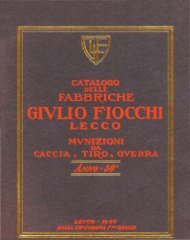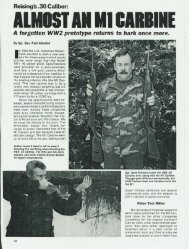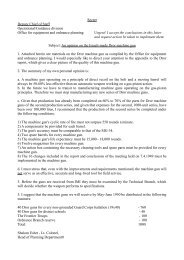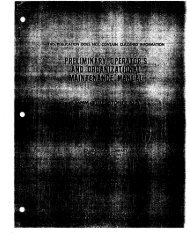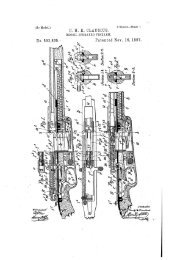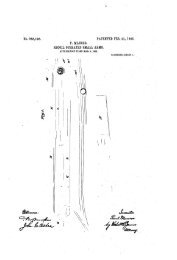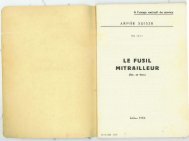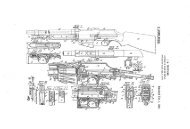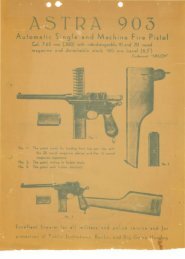Ross Rifle 1907 Manual.pdf - Replica Plans and Blueprints
Ross Rifle 1907 Manual.pdf - Replica Plans and Blueprints
Ross Rifle 1907 Manual.pdf - Replica Plans and Blueprints
You also want an ePaper? Increase the reach of your titles
YUMPU automatically turns print PDFs into web optimized ePapers that Google loves.
14<br />
A hole is drilled right through its left side into the screw thread <strong>and</strong> a<br />
small hardened, pointed pin, called the cock-ing piece plunger, is inserted<br />
in this bole wluch is afterwards slighlly closed with a l1ammer to prevent<br />
the plunger from falling out. It cannot fall inwards as the bole is drilled<br />
slightly off centre to the thread which accordingly forms a shoulder for it.<br />
When the bolt is assembled, tbis plunger engages one of the flats on<br />
the firing pin to prevent it from turning <strong>and</strong> is itself prevented from<br />
coming out by contact with the inner surface of the bolt sleeve, its point<br />
being rounded off to prevent friction or burrs.<br />
F'rom the underneath side of the cocking piece a rib projects wbich<br />
travels along the slot in the bolt sleeve <strong>and</strong> keeps the cocking piece from<br />
turning, <strong>and</strong> on this rib is a "bent" wbich is engaged by the nose of the<br />
sear to hold back the cocking piece <strong>and</strong> firing pin at full cock.<br />
Safety Catch.-The safety catch consists of a bolt into wbich is driven<br />
a pin having a milled knob. A vertical hole is drilled in wbich a punch<br />
can be inserted to depress lhe safety catch plunger spring when removing<br />
the safety catch.<br />
On the under side is a flat in wbich are cut transversely two grooves.<br />
The safety catch plunger actuated by its spring engages these grooves to<br />
prevent the accidental slipping of the safety catch from the "locked" <strong>and</strong><br />
"unlocked" positions respectively.<br />
On the rear surface is a cam which engages the front cut of the cocking<br />
piece already mentioned <strong>and</strong> withdraws the "bent" from the nose of the<br />
sear when the action is placed at "safety."<br />
The right end of the safety catch is cut at an angle to come flush with<br />
the bolt sleeve when assembled, <strong>and</strong> the left end acts as a locking bolt, a<br />
flat being cut to engage against a corresponding flat on the left side of<br />
the receiver <strong>and</strong> so prevent the opening of the bolt when set at "safety."<br />
Ejector.-The ejector is a flat piece of steel which works in a slot on<br />
the left side of the receiver, being held by a pin <strong>and</strong> actuated by a spring<br />
wbich presses its point inwards towards the bolt. Its right side is shaped<br />
so that by contact with the cam in the left side of the bolt it is withdrawn<br />
when the rifle is being loaded hut its pointed front end is allowed to intercept<br />
<strong>and</strong> eject the empty case when the bolt is withdrawn.<br />
Extractor.-The extractor is of sheet steel with a claw at its front end,<br />
<strong>and</strong> a lug on its underside wbich engages the rear edge of the bolt head<br />
<strong>and</strong> takes the resistance during extraction. Tbis lug also prevents the<br />
extractor from dropping out when the bolt is not in the rifle.<br />
Towards its rear end is n slot wbich can be used in case of necessity<br />
to hold the firing pin by its flats when stripping or assembling the bolt.<br />
It is secured to the bolt sleeve by fitting into two undercut grooves on<br />
its upper surface <strong>and</strong> is so placed that it wi!J prevent the bolt bead from<br />
turning beyond its pathway when the bolt lugs are unlocked. The front<br />
of the hook is rounded to let the natural spring of the extractor carry it<br />
over the rim of the cartridge on closing the bolt.<br />
Sear.-The sear is a triangular piece of steel of U section which fits<br />
inside the pawl to which it is attached by the sear pin. It is drilled to<br />
take the trigger pin wl1ich connects the trigger to it <strong>and</strong> is slotted <strong>and</strong><br />
15<br />
recessed for the sear spring <strong>and</strong> pawl spring which control its action in<br />
connection with the pawl <strong>and</strong> receiver.<br />
Its rear angle forms the "nose" to take the "bent" of the cocking<br />
piece.<br />
Pawl.-The pawl is also a triangular piece of steel of U section drilled<br />
to take the sear pin <strong>and</strong> reces ed <strong>and</strong> grooved to form a seating for the<br />
pawl spring.<br />
Trigger.-The trigger is in the form of a bent lever with an a.-cis hole<br />
at its bend. Its long arm is curved to form a finger grip <strong>and</strong> its short<br />
arm projects to the rear <strong>and</strong> bears against the bottom of the receiver to<br />
le,·er the sear from the cocking piece when trigger is pressed.<br />
Magazine.-The magazine is a vertical box entirely enclosed by the<br />
stock <strong>and</strong> fastened to the trigger guard by two screws on its underside.<br />
The front end is left open for the up <strong>and</strong> down movement of the lifter.<br />
It contains five cartridges. Its rear end is brazed for strength <strong>and</strong> has<br />
two slots on top to form guides for the horns of the cut off.<br />
Lifter.-Tbe lifter is a long steel bar having the magazine platform<br />
rivetted on to its rear end <strong>and</strong> working inside the magazine. It is situated<br />
below the barrel in the stock to which it is pivotted at its front end by a<br />
nut <strong>and</strong> screw.<br />
About half way along it the lifter finger piece is rivetted which projecting<br />
from the right side of the stock forms a grip for the left h<strong>and</strong> to<br />
work it up <strong>and</strong> down against a spring on the controllable platform principle.<br />
Cut Off.-The cut off is a sheet steel stem passing bebind the magazine<br />
<strong>and</strong> through a hole in the top of the trigger guard. It is curved at its<br />
lower eJo.-tremity to form a hook for the thumb.<br />
It has two projections pressed out respectively to the front <strong>and</strong> rear of<br />
the stem.<br />
The front one forms a "bent" wbich engaging a slot in the front of<br />
the trigger guard holds it in its downward or "on" position. The rear<br />
one forms a seating for the cut off spring whose upper end has a point<br />
wbich enters vertically into a small hole in tlus projection.<br />
The lower end of the cut off spring has a similar point wbich enters a<br />
similar hole in the top of the trigger guard.<br />
The top of the cut off is bent to the front to form two horns wbich lie<br />
0\"er the magazine platform <strong>and</strong> are kept in place by the slots in the rear<br />
end of the magazine in wbich they work.<br />
Bolt Stop.-The bolt stop is a pin wbich works vertically in a dovetailed<br />
seating on the left side of the receiver at its rear end. Its top is<br />
rounded <strong>and</strong> knurled to form a thumb grip. Its bottom end is recessed<br />
to receive the bolt slop spring which lies in the stock below it.<br />
Its right face projects through a slot in the receiver <strong>and</strong> intercepts the<br />
lug on the front end of the bolt sleeve until the bolt stop is pressed down<br />
to allow it to pass.




